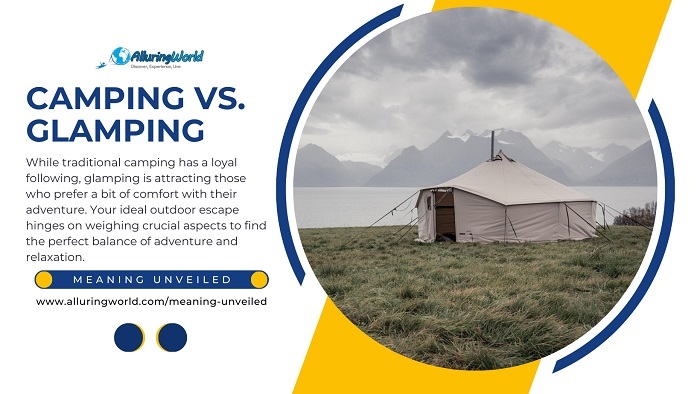Read time ca. 5 minutes
Outdoor experiences offer a great way to connect with nature, unwind, and explore the world around us. While traditional camping has a loyal following, glamping is attracting those who prefer a bit of comfort with their adventure.
With options ranging from rustic campsites to high-end tents, both camping and glamping present unique experiences, benefits, and challenges. Choosing the right one depends on your personality, preferences, and comfort levels in the great outdoors. Keep reading to learn all about it.
From selecting the appropriate gear to understanding the distinct experiences each offers, delving into the activities available, considering your budget, and determining which is more family-friendly, there’s much to explore. Your ideal outdoor escape hinges on weighing these crucial aspects to find the perfect balance of adventure and relaxation.
Choosing the Right Outdoor Gear:
Selecting appropriate outdoor gear can affect your camping or glamping experience so that you have what you need to enjoy your adventure. For traditional camping, bring a sturdy tent, a comfortable sleeping bag, and cooking equipment suitable for a campfire. Depending on your destination, you may want to pack hiking gear, a first aid kit, and weather-appropriate clothing.
Glamping comes with a broader range of luxurious items, including high-quality bedding, portable heaters, and even outdoor furniture. For both camping and glamping, many adventurers turn to suppliers like Nakie outdoor gear for stylish and functional items. Regardless of your preference, investing in the right gear tailored to your camping or glamping style can elevate your experience and make your outdoor adventure unforgettable.
The Traditional Camping Experience:
When people think of camping, they picture setting up a tent in a serene location, cooking meals over a campfire, and sleeping under a blanket of stars. Traditional camping emphasizes a back-to-basics philosophy, encouraging people to embrace nature and disconnect from modern conveniences. Campers prepare for their trips by gathering tents, sleeping bags, and cooking gear for a self-sufficient approach.
Traditional camping cultivates a sense of community; campers bond with friends, family, and fellow adventure enthusiasts. Some people find the simplicity of camping rejuvenating. Know that camping may not be suitable for those who prefer more comfort during their outdoor activities.
The Luxurious Twist of Glamping:
Glamping, a mix of “glamorous” and “camping,” offers a more luxurious alternative to traditional camping, appealing to those who seek adventure without sacrificing comfort. Glamped accommodations can range from safari tents with spacious interiors to cabin-like structures equipped with modern amenities. People can enjoy the beauty of nature and indulge in plush bedding, gourmet meals, and private bathrooms.
Many glamping sites cater to specific themes, incorporating stargazing, wellness retreats, or gourmet dining under the stars. For those who love the outdoors but feel tentative about roughing it, glamping may strike the perfect balance. Adventurers can now embrace outdoor adventures with the assurance that they can retreat to a cozy space at the end of an exhilarating day.
Activity Options:
Both camping and glamping present ample opportunities for various outdoor activities. Traditional campers engage in hiking, fishing, canoeing, or swimming in nearby lakes or rivers, embracing the rugged charm of the landscape. Set up a campfire to invite storytelling and camaraderie among friends and family while allowing for roasting marshmallows or preparing warm meals.
Those who opt for glamping can take advantage of guided tours, spa treatments, or organized workshops that focus on local culture or skills. Many glamping sites offer picnic packages or private dining experiences, elevating culinary options to match the delightful surroundings. This combination of adventure and relaxation provides something for everyone.
Budget Considerations:
When comparing camping and glamping, keep budgeting in mind. Traditional camping requires a lower initial investment, as many campsites charge modest fees for entry or overnight stays. Campers can save money by sharing gear with friends, cooking their meals, and forgoing extravagant amenities.
Glamping demands a higher budget, as accommodations come with added costs for luxury experiences and conveniences. Glamping sites vary in price based on location, amenities, and experience. Many guests find that the premium experience is worth it due to the convenience and comfort they receive. Budget-conscious explorers need to weigh their options carefully, balancing their desire for adventure with financial considerations to secure the best experience tailored to their needs.
Which Experience is More Family-Friendly:
Choosing between camping and glamping depends heavily on the age and preferences of the family members involved. Traditional camping can promote teamwork among family members: they work together to set up tents, build fires, and prepare meals. Children may find joy in exploring and connecting with nature, engaging in activities like fishing, stargazing, or identifying plants and animals.
The luxury of glamping caters to families seeking convenience or comfort. Glamping sites provide family-friendly amenities such as easy access to clean bathrooms and prepared meals, and make the experience more enjoyable for all ages. Families should consider their comfort levels, required amenities, and preferred activities when deciding between the outdoor experiences.
Conclusion:
Outdoor adventures in nature can fulfill a variety of desires and expectations. Traditional camping offers a rugged experience steeped in self-sufficiency and personal growth, whereas glamping provides a luxurious and comfortable alternative that appeals to those who prefer a more laid-back approach. By carefully weighing the factors outlined above, you can embark on the perfect outdoor adventure that meets your specific needs and desires.

